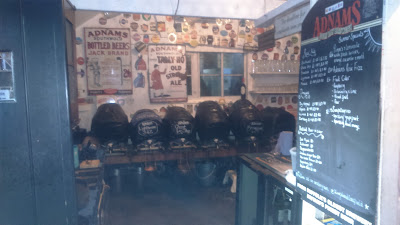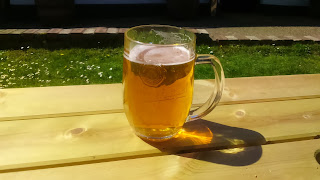Over the Bank Holiday weekend I made another trip up to Norfolk, not only to see dad, but also to assist my sister and my two nieces in
clearing out my parents’ bungalow. We have found a buyer for the property, as
it seems senseless keeping on a place which stands empty for most of the time.
Dad’s condition is unfortunately worsening, so there is no chance of him being
able to return and live there independently on his own.
The sale of the family home will go towards keeping dad safe
and comfortable in the care home, where he has settled in nicely, but it was still a heart-wrenching couple of days,
having to rake through our parents possessions, deciding what to keep and what
to dispose of. I travelled up on the Saturday evening, with my son, having first
collected him from work, and with an arduous weekend ahead, it seemed a good
idea to stop for some sustenance on the journey up.
 Where better then than to cross another pub off CAMRA’National Heritage list, and looking at the map, the unspoilt King's Head at
Laxfield seemed the ideal stopping off point. The pub might have taken a bit of
finding, but this time we had the benefit of my recently acquired Sat Nav, and this device saved countless stops to look at the map and
potentially several wrong turns.
Where better then than to cross another pub off CAMRA’National Heritage list, and looking at the map, the unspoilt King's Head at
Laxfield seemed the ideal stopping off point. The pub might have taken a bit of
finding, but this time we had the benefit of my recently acquired Sat Nav, and this device saved countless stops to look at the map and
potentially several wrong turns.
The King's Head is also known as the “Low House”, probably on
account of its long low profile, which is topped by a thatched roof. It is a
timeless, multi-roomed pub, and is one of two hostelries in this attractive, mid-Suffolk
village. It takes a bit of finding, as it is tucked away down a narrow lane, at
the back of the church, but fortunately modern technology took us straight
there.
We arrived, shortly before 8.30
pm and found the car park, and most of the lane outside already full with
parked vehicles. Fortunately we managed to squeeze the car in just below the
church, and soon discovered the reason for the pub’s popularity; the King's Head
was hosting its annual May Bank Holiday Beer Festival. Featuring
over 35 Real Ales, Craft Beers and Ciders, together with food and live music,
this would have been a great place to spend the evening (or possibly even the
weekend), had we not had further to travel.
 |
| The high-backed settle, designed to keep the draughts away. |
We found our way into this room, pausing for a look at the
high-backed settle which takes up much of the space, before
proceeding to the aforementioned tap room, at the end of the corridor. Here we
could see a row of casks racked ready to dispense a range of Adnams beers. We
asked about food, only to be told that all tables were booked, but fortunately
there was some space in the smoking shelter, out in the yard adjacent to the tap-room.
 We grabbed a couple of spare seats then I went off to the serving
hatch to order our beers and also our food. As I was driving I opted for the
ordinary Adnams Southwold Bitter (NBSS 3). Matt on the other hand, opted for a pint of Adnams
Dry- Hop lager. To eat we both went for the steak and ale pie option, served
with chips and peas. Service was quick, despite the crowds, and our food
arrived promptly. The pies were not “proper” pies, but the steak was juicy and
tender, and the gravy filling was suitably thick and tasty. After a two and a
half journey, the end part of which was through a series of winding lanes, we
were both famished, and our meals were gratefully appreciated.
We grabbed a couple of spare seats then I went off to the serving
hatch to order our beers and also our food. As I was driving I opted for the
ordinary Adnams Southwold Bitter (NBSS 3). Matt on the other hand, opted for a pint of Adnams
Dry- Hop lager. To eat we both went for the steak and ale pie option, served
with chips and peas. Service was quick, despite the crowds, and our food
arrived promptly. The pies were not “proper” pies, but the steak was juicy and
tender, and the gravy filling was suitably thick and tasty. After a two and a
half journey, the end part of which was through a series of winding lanes, we
were both famished, and our meals were gratefully appreciated.
Whilst we were eating, we could see people coming and going
to the beer festival. Entrance was £5 a head, with a wrist-band for
re-admittance, and most of the customers seemed to be people in their 20’s or
30’s. It was pleasing to see a significant proportion of them were women;
something which soon caught the attention of my twenty-something son; although
I confess I gave several of them more than a passing glance as well.
As I said earlier, it would have been nice to have stayed
longer. Had we been better prepared, we might have found somewhere to stay in
the village for the night, and then made more of our time at the King’s Head,
but having found it, and experienced the pub first hand, I know I will be
making a return visit sometime in the not too distant future.
Apologies for the quality of some of the photos;
particularly the interior shots. My phone doesn’t really do justice to the pub;
although in mitigation it is not easy taking photos “on the hoof”, when there
are people scattered all around you.
For some proper “professional” photos, take a look here on the
Heritage Pubs website, although it must be said, their photographer had the
benefit of an empty pub, plus time on his side!










































